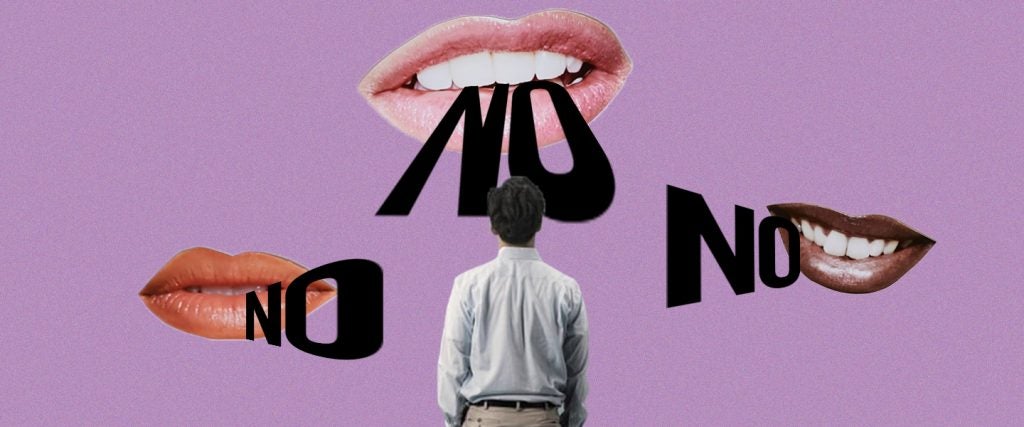In 2017, at the height of the cultural conversation around “toxic masculinity,” the idea of romantic rejection began to creep into the zeitgeist. Whether it was the 49-year-old man who shot up a birthday party after a breakup or the 32-year-old who murdered his wife and seven of her friends after she filed for divorce, or any of the other terrifying accounts of women who were violently attacked by men they rejected, some men’s dangerous inability to cope with “no” inevitably took center stage.
That same year, an entrepreneur by the name of Jia Jiang offered a counterpoint: What if guys could practice rejection by turning it into a game? The rules were simple yet ambitious: “Every day you get rejected at something,” for a total of 100 days, Jiang explained in a TED Talk. “And then, by the end, you desensitize yourself to the pain.”
The rejection scenarios Jiang pursued daily were mostly humorous and low stakes, like asking a stranger for $100, or a restaurant worker for a “burger refill.” And to be fair, Jiang isn’t the first man to attempt to gamify rejection. He even admitted in his TED Talk that the idea came from a card game he stumbled on called Rejection Therapy, which was invented by a Canadian guy named Jason Comely in 2009, who came up with the premise after his wife left him. Comely’s rejection cards were slightly more straightforward than Jiang’s, and set up the player to do much more basic things like striking up a conversation with a stranger.
But regardless of the cards, the broader trend wasn’t just for men — everyone wanted in on gamifying rejection. Young professionals all over the country were rising to the “rejection challenge.” And in 2018, comedian and writer Emily Winter set out to top Jiang with 101 rejections. “I felt empowered by the knowledge that turning my failures into accomplishments would mean I’d be gaming the system,” she wrote in the New York Times. “Both acceptances and rejections would count as a sort of win, and I liked those odds.”
Rejection therapy might not be entirely original, but it’s also not really therapy either. That’s because “therapy isn’t a solo activity. Even therapists aren’t able to do therapy alone,” explains psychotherapist Tracy Pryce. The game, however, does have some similarities to exposure therapy, a type of psychological treatment that helps individuals learn to deal with irrational and debilitating fears and phobias, like heights or public speaking, through gradual exposure. However, the crucial difference between exposure therapy and a game that imitates it is a mental health professional who is trained to make sure that the exposure is helpful and not overwhelming.
For instance, “if you want someone to overcome a fear of snakes, don’t drop them in a pit of snakes,” Pryce tells me. “That can flood and overwhelm them, even to the point of trauma.” There are degrees of exposure that are very delicate when it comes to exposure to snakes, rejection or any other fear, and the exposure has to be gradual, intentional and closely monitored. “We don’t want people overcoming a fear of heights to fall off the edge of the Grand Canyon taking a selfie,” Pryce warns.
Still, by sticking to lower-stakes scenarios, clinical psychologist Carla Manly believes Jiang offers some men a safe place to start. With exposure therapy, “the upsetting stimulus is kept at a low level to overcome an intense reaction that causes great fear and distress,” Manly says. “In the same way, humorous rejections such as requesting a ‘burger refill’ can build tolerance for real-life rejections.”
But it’s important to note that Jiang, who didn’t respond to requests for comment, didn’t include getting rejected for sex or any other romantic rejection in his personal experiment. This is significant given that research shows that being rebuffed in such a manner is one of the most volatile and dangerous types of rejection. So while Jiang’s method may be a jumping off point, the question is, where do guys go from there?
As his bio states, Jiang acquired the game from Comely and now offers three different versions available online for $10 a deck. The “Classic” Edition does include a number of emotionally precarious scenarios, such as “reach out to a friend or family member who has shunned you,” “try to make an enemy a friend” and “confess to someone you lie to.“ The game also includes asking someone out and asking for a phone number.
For your average person with high emotional intelligence, a strong support system and a good sense of humor, “there’s generally no reason not to pursue rejection therapy,” Manly says. However, someone who is struggling with rejection and in a fragile place should seek out professional help rather than try to gamify things.
“No matter what may work for others, it’s most important to embrace approaches to mental health that work for you and your own needs,” Manly says. “Men, in particular, often forget that they have the right — and even the responsibility — to tune into their own needs regardless of what the competition is doing.”
So if rejection feels genuinely excruciating, beating your head against it for 100 days in a row isn’t going to get you anywhere. Unless, of course, you could really use a burger refill.

